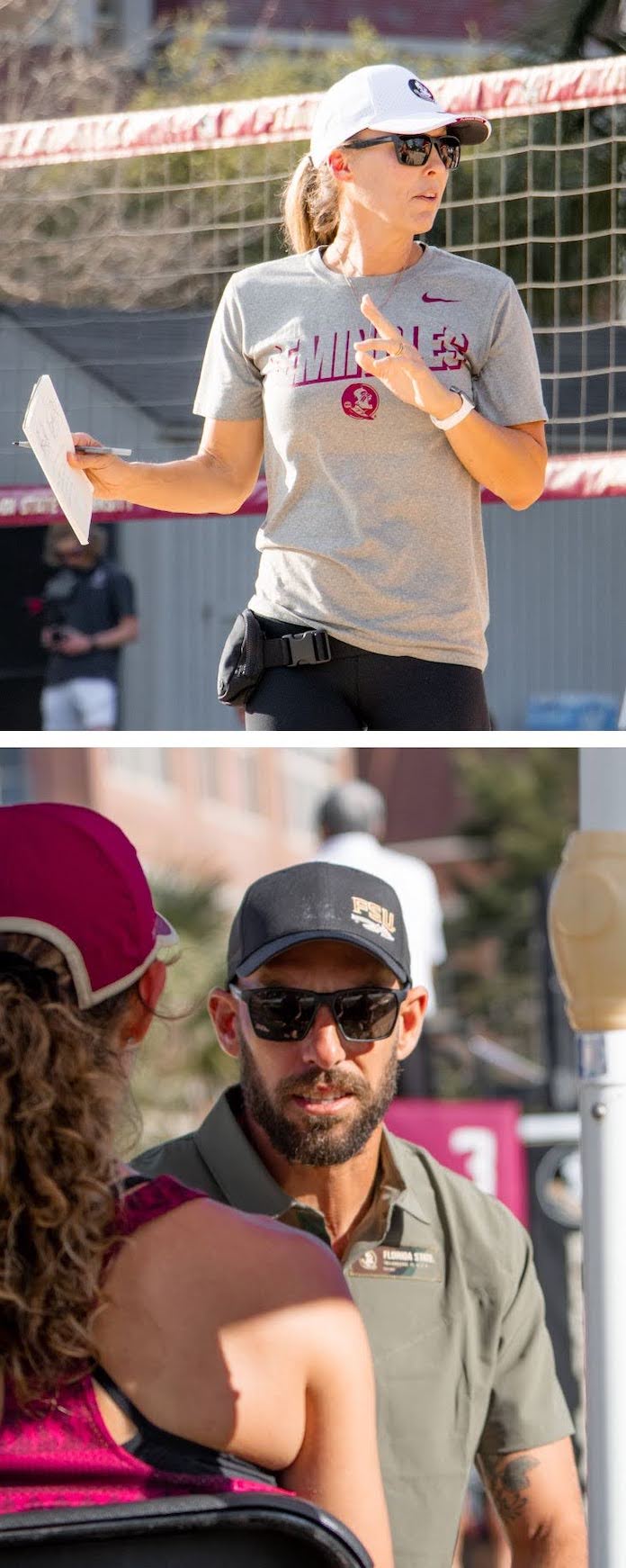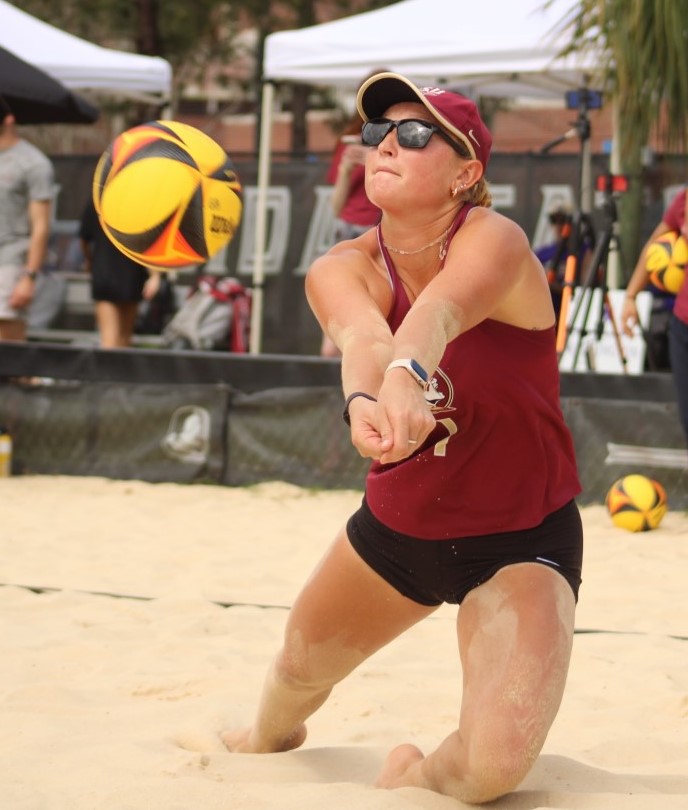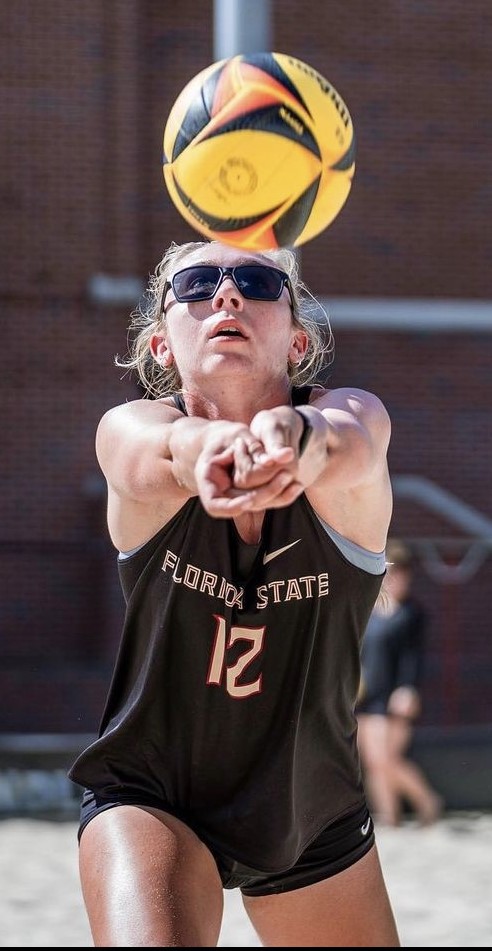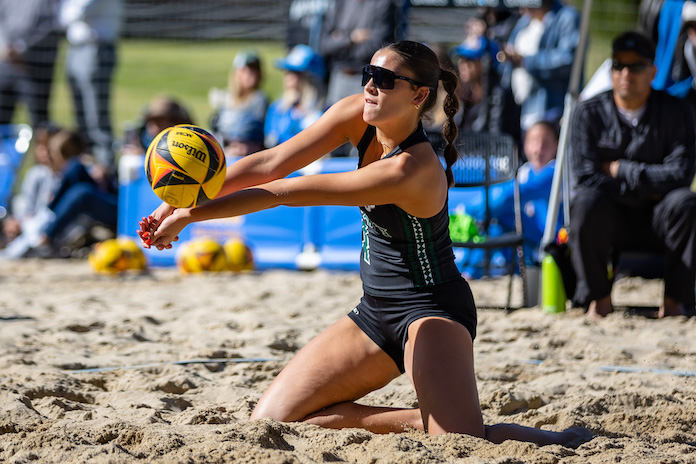Crabb-Brunner survive China-Brazil travels, advance into Brasilia Elite16 main draw
May 1, 2024
March 30, 2023
This week in college beach volleyball, the East Meets West Invitational is on fabled Manhattan Beach in a competition with undeniable postseason implications. In a wide-ranging interview, Brooke Niles, coach of No. 4 Florida State, talks about returning home to Southern California for the East-West, as well as the bigger picture of seeding for the NCAA Championships. We run down other action on a full weekend, and finish with an honor roll of conference pairs of the week.
The focus this weekend turns to the hallowed sands of Manhattan Beach, California, where a stacked intersectional competition should provide a hard drive’s full of meaningful data for the NCAA Championship selection committee to weigh.
The East Meets West Invitational on Friday and Saturday, played on the deep sand of Manhattan Beach, in the shadow of its iconic pier on the South Bay, features five of the top eight teams in the country and eight of the top 16.
The results figure to factor heavily in the eight at-large bids to the NCAA Championships (May 3, 5-7) in Gulf Shores, Alabama, and likely will influence the seeding for the 17-team, single-elimination tournament by providing the committee with compelling head-to-head results. Four teams from the West (No. 2 UCLA, No. 3 USC, No. 7 Loyola Marymount and No. 8 Hawai’i) will battle four from the East (No. 4 Florida State, No. 5 LSU, No. 11 Georgia State and No. 16 Florida International) in 16 crossover duals over the two days.
The West’s lineup represents a Murderers’ Row for the East programs, with none remotely resembling a breather.
USC (13-1) has taken down eight ranked squads, including Pac-12 archrival UCLA, and its only loss is to undefeated TCU, the unanimous No. 1 in this week’s AVCA poll.  Loyola Marymount (16-1) displayed its dominance of the WCC over the weekend by winning the West Coast Challenge, all four matches by 5-0 scores. The Lions hold victories over six ranked teams.

Nine ranked squads have fallen to UCLA (19-1), which ran its winning streak to 10 with a 4-1 victory over Hawai’i (20-4) on home sand Wednesday at Mapes Beach. The Rainbow Wahine had a streak of 18 duals snapped by the Bruins after they had run the table in the Big West Challenge. UCLA’s top pair for that dual of Abby Van Winkle and Peri Brennan breezed in a 21-10, 21-12 cakewalk over Brooke Van Sickle and Kaylee Glagau, who dropped from No. 1 to No. 2 at the 1s in CollegeBeachVB.com’s ranking as a result.
Meanwhile, the East squads can make compelling cases to the selection committee with strong showings against such daunting competition.
FSU (21-2) has fallen only to TCU and UCLA, and has beaten nine ranked foes. The losses incurred by LSU (17-5) have been to TCU (twice), Florida State (twice) and UCLA. The Tigers have four victories over ranked opponents.
Georgia State (13-7) is the only ranked team among the Sun Belt Conference’s eight programs. The Sandy Panthers are 2-8 against present Top 20 squads, so the automatic bid awarded to the Sun Belt Tournament champion might be their only route to the NCAAs unless they pull upsets this weekend.
FIU (9-9) has scheduled tough all season and will play duals against 10th-ranked Stanford and No. 12  Long Beach State on Thursday before the East Meets West cranks up. Going into that tri-dual, the Panthers from Miami were 0-9 against teams in this week’s Top 20 and are one of three ranked squads in the six-team Conference-USA.
Matches from the East Meets West Invitational can be viewed online through the UCLA live stream via Pac12.com.
FSU has built a formidable legacy in beach volleyball and, as the No. 4-ranked team in the country, has every expectation of again being a high-profile player in the NCAA Championship.
The Seminoles have come so close to national titles, taking second-place trophies back to Tallahassee in four AVCA or NCAA tournaments, three under Coach Brooke Niles since beach volleyball became a fully NCAA-sanctioned sport in 2016. Niles is fully aware of how important this weekend’s East Meets West duals are as a barometer for her team.
“We are really excited to be back in this tournament,†she said. “We missed it last year. It’s a great opportunity to see how our lineup stacks up against teams that potentially will be at Gulf Shores, to see how we measure up against competition that we normally don’t get to play.
“We just finished playing LSU [last weekend] for the second time. We’ve played TCU already. We don’t normally play USC and UCLA and Hawa’ii unless those teams travel out here. We haven’t faced Hawai’i in a few years and they always play us really tough. Our focus always is on getting better. We have a tough four weeks ahead of us — five weeks of you count the NCAAs — and we’re just hoping to build some momentum. Playing these highly ranked teams will tell us a lot about what we need to work on for the next few weeks after that.â€

Niles is a native Southern Californian, and Manhattan Beach holds special meaning as well for her husband, Nick Lucena, a Floridian who serves as the Seminoles’ assistant coach. Lucena, 43, ranks among the most decorated American beach players in history, collecting 29 titles on domestic or world tours, and representing the United States in the 2016 Rio and 2021 Tokyo Olympics with Phil Dalhausser. He has three plaques on the iconic Manhattan Beach Pier commemorating the Manhattan Beach Opens he won with Dalhausser in 2015, ’17 and ’18.
A SoCal homecoming, Niles said, “is a wonderful opportunity for us in one of the meccas of the beach-volleyball world. My husband and I used to live right there in El Segundo. Nick has his name on the pier three times, so we always are excited to go back to California.â€
Having a coach with the impeccable credentials of a Nick Lucena on the FSU staff has made a significant difference in the program on multiple levels.
Niles: “My assistant coach is a two-time Olympian who can tell the players, ‘Hey, in this situation, this is what I would do against a 6-11 blocker on the world tour.’ ”
But, coach, are your girls truly aware of who Coach Lucena is?
“Now I would label him as the best women’s blocker, because he plays against our team,†Niles said with a laugh. “Nick will never talk about himself. He’s so humble and he’s such a hard worker. But it’s pretty cool to see the relationship he has with our players, how he coaches, and how he uses his experience to get the best out of them. The level of our training has changed just because of his intensity, and that’s just who he is. It’s really a benefit for them to see that, hey, if you want to be successful, these are the characteristics you should probably strive to get.â€
Niles enjoyed a solid career on the sand as well, particularly when partnered with 2016 U.S. Olympian Lauren Fendrick. She was named the Best Defender on the AVP Tour in 2009 and Best Defensive Player in the National Volleyball League series in 2014. Niles collected six titles on various domestic tours, with much of her success coming with Fendrick during the AVP’s bankruptcy period in 2011 and ‘12.
But Brooke, 42, just chuckled when prodded about whether she still hits the sand: “Oh, I’m so old, I actually got asked the other day if I played beach volleyball by a parent. And I was like, well, yeah, I did that.â€
The Seminoles have a player who already has achieved noteworthy success at the pro level in Floridian Maddie Anderson, a 6-foot-1 redshirt junior who earned AVCA first-team All-American honors in 2022 and was CollegeBeachVB.com’s Breakthrough Player of the Year. After the collegiate season, Anderson, 21, competed in three Volleyball World tour stops with Molly Turner, winning a Futures-level tournament in Italy in July and earning the silver medal in a second-tier Challenger event in Dubai in October. Seeded 14th, Turner and Anderson were beaten in the final by the top-seeded German veterans Julia Sude and Isabel Schneider.

“Maddie Anderson has played at 1s the last two years,†Niles said. “She had an amazing season last year teaming with an experienced player in Brook Bauer. Maddie has grown as a player. Her development the last two years has been unbelievable. She played on the world tour this summer and she’s going to play AVP this next summer. She has risen to the challenge of playing against better and better competition. Maddie has been a staple for us at the 1s.’
Anderson’s partner is junior Paige Kalkhoff, who transferred to FSU from Florida International, where she played in the top pair.
“Maddie and Paige are going to get better and better the more they get used to playing with each other as a team and playing in our style,†said Niles, who is 222-46 (82.8%) at the Seminoles’ helm. “Paige is still learning how we do things. They have improved each weekend, and they performed really well this past weekend. They had a tough match against Washington, and we had lost to that 1s pair [of Chloe Loreen-Natalie Robinson] when we played them at the beginning of the year at home, and this time they were able to beat them in three.
“Their confidence is getting higher each weekend. They know that every match is going to be a challenge, but for us as a program, whenever our 1s pair is really good, our team seems to perform better. Maddie and Paige are a tough team to play and a tough team to beat, so that sets the tone for the rest of our lineup.â€
Dead ahead for Anderson-Kalkhoff might be three of the top four teams in CollegeBeachVB.com’s rankings of 1s pairs: UCLA’s Lexy Danaburg-Maggie Boyd (first), Van Sickle-Glagau (second) of Hawai’i and Valma Prihti-Melanie Paul (fourth) of Loyola Marymount.
FSU has been strong up and down the lineup, with 5-foot-9 redshirt freshman Makenna Wolfe and 5-10 freshman Alexis Durish, the 5s pair, turning into a buzzsaw of late. Over the last two weekends of competitions, Wolfe and Durish have gone undefeated in eight matches, outscoring their opposition 352-236 in 18 sets.

“Both of the girls are just really good volleyball players,†Niles said. This is a team that had never played together and we put them together a couple of weeks in, just knowing as individuals that they have been so solid. Alexis, as a freshman, is so smooth and so composed, and has so many tools. Makenna didn’t play last year. She just worked really, really hard and is in unbelievable condition. She gets served every ball and does not get tired. She makes amazing plays with her speed and aggressiveness.
“It has been so great to have them there because of how they have executed. They played in a lot of heavy wind in [the tournament at] Gulf Shores and they seemed to thrive in those moments. It’s a nice treat to have that [at the 5s]. The 5s is really the most pressure situation. No one is really expected to win the 1s unless you’re a truly dominant team, because those matches would go either way. Whereas the 5s and the 4s, [a coach] expects to win those [matches] for your team and then, hopefully, you can steal a 1, 2, 3.â€
While discussing the potential implications of at-large bids and seeding spurred by the crossover competition this weekend, Niles opened up on the broader issue of the methodology used by the NCAA selection committee in beach volleyball and the glaring lack of metrics that are taken for granted in sports such as basketball, and even indoor women’s volleyball. The NCAA Championships will have automatic bids from the Pac-12, CCSA, Big West, West Coast, Atlantic Sun, Conference-USA, Southland, Ohio Valley and Sun Belt (new for 2023) conferences. A play-in dual between the 16th and 17th seeds will be contested on the Wednesday before the main draw begins in earnest on Friday in Gulf Shores.
“It’s still a little like the Wild West with NCAA seeding,†Niles noted. “There is no RPI yet, and I think that has to come into play. Strength of schedule [should be factored], because somebody could be seeded high and at the end of the year, they don’t play top 15 teams. In general the coaches I talk to love the [automatic qualifiers] but we would like to see our field grow a little more first. [With 17 teams and nine] AQs, how do you seed them? I’m not on that committee, but there needs to be a hard look at seeding and RPI. An RPI could change a lot of things, because maybe coaches will try to play a stronger schedule, especially near the end.â€
In FSU’s situation, gaining the automatic bid that comes with winning the CCSA Tournament likely isn’t a necessity. But the CCSA numbers four teams ranked in this week’s AVCA top six and five in the top 15. Is it likely that half of the eight at-large bids would come from that one conference? The Pac-12 also has five in the top 13 and six in the top 18. Hawai’i and Long Beach State of the Big West are in the top 12. The pure numbers tell us that at least one program ranked 16th or higher, perhaps more, will be shut out of the NCAA field.
“Our conference tournament is going to be huge because everyone will want that automatic bid,†Niles acknowledged. “With single-elimination, seeding [in the NCAAs] is going to be even more important.â€
No. 1 TCU, No. 17 Stetson, No. 19 Pepperdine and Florida Gulf Coast join the host Ospreys in Jacksonville for the North Florida Invite on Friday and Saturday. Pepperdine comes off a third-place finish in the West Coast Challenge. The Mustang Invitational in San Luis Obispo, California, will see No. 9 California, No. 13 Washington, No. 20 Tulane, UC Davis (a potential poll “lurker†at 13-6) and upstreaming host Cal Poly battle on Saturday and Sunday. No. 10 Stanford and NAIA program Vanguard will play in a tri-meet Friday with No. 12 Long Beach State at Rosie’s Dog Beach. The Wildcat Spring Challenge at Bear Down Beach in Tucson on Friday and Saturday will include No. 19 Arizona, Missouri State, Santa Clara, UTEP and Colorado Mesa.
No. 6 Grand Canyon looks to ease the sting of a 3-2 defeat to TCU last weekend, hosting a tri-meet Saturday against Phoenix-area NAIA programs Park Gilbert and Ottawa. Louisiana Monroe carries a 19-1 record and a six-dual winning streak into the UAB Beach Classic in Birmingham, Alabama, joining the host Blazers, Mercer, Austin Peay and Jacksonville State. Having clinched the Southland Conference regular-season title, Texas A&M-Corpus Christi will entertain Stephen F. Austin, Texas A&M-Kingsville and Houston Christian in its Islander Classic.
Earlier in the week we recapped last weekend’s top results.
Conference pairs of the week include TCU’s Daniela Alvarez and Tania Moreno, CCSA (for the third time this season); Liz Waters-Leiga and Sierra Caffo of Cal, Pac-12; Kaylee Glagau and Brooke Van Sickle of Hawai’i, Big West (for the second time in 2023); Georgia State’s fiery Angel and Bella Ferary, Sun Belt; Stephanie Young and Logan Mignerey of Florida Atlantic, Conference-USA; Paula Klemperer and Taylor Seney of North Alabama, Atlantic Sun; Shea Slusser and Kela Moreno of Texas A&M-Corpus Christi, Southland; and Tennessee Martin’s Kambree Lucas and Olivia O’Keefe, Ohio Valley.
